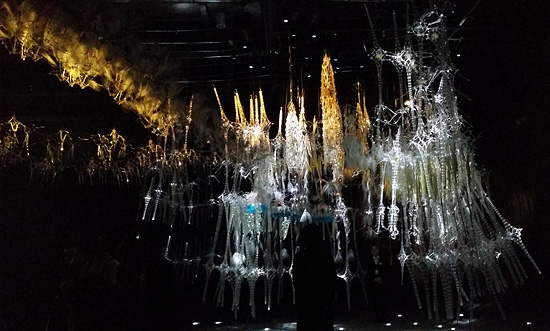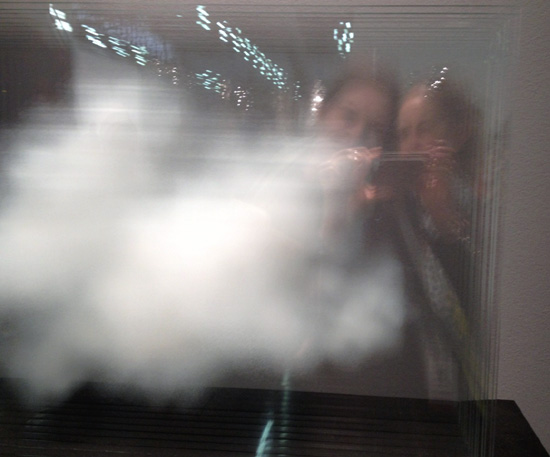New Cultural Waves In SEOUL
Museum Of Modern And Contemporary Art
March 26th 2014 – MMCA in Seoul

한진해운 박스프로젝트, 서 도 호 , <Hanjin Shipping The Box Project: Do Ho Suh>
Home within Home within Home within Home
한국미술 국제적인 시각으로 겨냥한다
시카고 엑시스 국제아트페어 디렉터 권미연 올림
Correspondent, Mi-yeon Kwon, Artist & Executive Director of Prak-sis, March 26th 2014
(translation to english follows)
(translation to english follows)
현대국립미술관 방문은 3년만에 찾은 고국 땅 에서 미술에 대한 깊은 인상을 준 곳으로 서울에 새롭게 지어졌다. 한국 미술문화를 확연히 새로운 경지로 이어줄 곳으로 굉장히 기대되는 이곳은 경복궁부터 인사동 사이의 고급스러운 상업미술관들 사이로 이국적인 자태로 우뚝 서 있다. 현대국립미술관은 내게 엘에이의 게티 미술관이 영상이 되게하였다.이 방문 속 3개의 인상 깊었던 전시들을 필자의 소견으로 짤막이 소개하려 한다. (http://www.moca.go.kr/)
첫째로 이미 한국 미술잡지에 소개된 바 있어 페이스북 담벼락에 올려놓았던 서도호 작가의 설치미술 Hanjin Shipping The Box Project : Do Ho Suh 는 굉장히 현대적이면서 또한 전통적인 이미지를 가지고 있다. 이 작품은 현 한국의 30대 후반에서 약 60대 미술 감상가들에게는 가슴으로 와 닫고 공감할 수 있고, 이 연령층보다 더 젊은 층은 교육받은 기술적인 두뇌로부터 시작된 감상이 가슴으로 전이되는 설치미술이 아닐까 하는 소견을 가지게 되었다. 그 이유는 아마도 이 건축물에 대한 경험에서부터 오는 것이 아닐까? 나의 세대만 해도 기와집은 가까운 가족 친지 분들께서 소유하고 계셔서, 그 속을 일년에 몇 번 정기적으로 경험할 수 있었던 세대였다. 하지만 지금 나와 동행해준 막 미대를 졸업하고 취직한 상태인 조카(24)는 기와집에 대한 경험은 박물관 혹은 민속촌이 아니였을까…성적을 위해 암기하던 그 서양건축물들, 영화 속에서 혹은 무대 위에서 보던 그 건축 디자인들, 혹은 유럽여행으로부터의 생생한 이미지들… 이렇듯 눈으로 받아들여지는 이미지가 가슴으로 관람객들에게 전해지고 있었다. 이러한 상상의 나래 속 가장 인상적인 것은 그의 설치물의 단색과 정교함이었다. 반투명하게 비치어내는 소재는 마치 작품을 거둘 때 금방이라도 찢어지지 않을까 하는 걱정도 자아냈다. 이 작품… 왜 그리도 마음에 남을까?

한진해운 박스프로젝트, 서 도 호 , <Hanjin Shipping The Box Project: Do Ho Suh>
Home within Home within Home within Home
두 번째로 제 7 전시실에 설치된 알레프 프로젝트는 굉장히 과학적이면서도 아름다운 설치물이다. 신비스러운 소리가 흘러나오는 설치는 아름다움을 두뇌로 감상하는 듯한 느낌이었다. 과학과 미술의 만남은 항상 쉽지 않다. 그렇기에 감상에 더 많은 시간이 소요되기도 하고, 어떤이는 “왜 이러한 작품이 태어났을까?” 혹은 “이것이 예술인가?” 하는 질문들을 하기도 한다. 하지만 이 작품에서 정교히 만들어진 빛과 소리를 공유하고 즐긴다는 것은 색다른 경험이었다. 한쪽 구석에 의도적으로 형성된 그림자 또한 인상적이다.

알레프 프로젝트, <The Aleph Project by Philip Beesley, Scale Free Network (media lab),
Edwin van der Heide (multi project hall), Hah Tesoc (Mezzanine)>
작품은 비디오 설치미술이다. 한국말 안에서 찾아낸 새로운 가능성을 보여준 현장제작 설치 프로젝트… 한글 자체의 직선적이고 경직된 느낌을 전시 벽 전체를 이용함으로써 새로운 탐색을 시도했다. 타국어와 비교하면 한글의 이미지는 매우 직선적이다. 사실 글자꼴의 아름다움 또는 문장이 가지고 있는 의미보다, 광대하게 스크리닝되는 자체가 오히려 더 관심을 끄는 비디오 설치미술 이었다. 이 문장이 무엇을 말하는 것일까 하는 관심이 가득한 관객이 오히려 설치작업 안 한켠을 장식한다. 그 경직된 글꼴이 오히려 인간의 육체가 만들어 내는 자연스러운 실루엣과 상반의 하모니를 그린다.

현장제작 설치프로젝트: 장영혜 중공업 <Site Specific Art Project: Young-Hae Chang
Heavy Industries Groovin’ to The Beat of The Big Lie>
앞으로 더 많은 도시인의 문화휴식공간으로 서비스될 이곳 단지 4천원으로 많은 것을 관람할수 있어 일반서민들에게 더더욱 기대되는 곳이다.
시카고 엑시스 국제아트페어 디렉터 권미연 올림.
Prak-sis Contemporary Art Association (이하 프락시스)는 2009년 1월에 시카고에서 설립된 다양한 국제 문화를 조화롭게 이해 시키는 것을 목적으로, 공간을 이주하며 역동적인 예술을 육성하는 비영리 예술 단체이다. 수 년간 많은 갤러리, 엑스포, 아트 페어와 협연한 프로젝트들이 있으며 2010년부터 지역사회 조직과의 예술적 소통과 상호이익을 위하여 크고 작은 프로젝트들을 전통미술분야부터 뉴 미디어 아트를 포함하여 실시하고 있다. 동시대의 국제적, 문화적, 세대적 틈을 연결시키며 국제 현대 미술계 속에서 하나의 독립체로 거듭나고 있다.)
Prak-sis (www.prak-sis.com) was founded in January 2009 as a not for profit art organization. Prak-sis is a dynamic art experience, migrating to diverse locations across the cityscape. Prak-sis had transformed building spaces rendered vacant due to a downturn in the market, obsolescence, or neglect into art galleries. From these experiences Prak-sis has developed exciting projects in art expos and gallery shows. Prak-sis Project aims to show that even in times of economic crisis, life can blossom, a culture can grow and most of all, hope need not die.
For projects since the Fall of 2010, Prak-sis has worked with small businesses and neighborhood support organizations for mutual benefit. With technology flooding our modern lives, we seek to promote art in new media as well as traditional art forms. Prak-sis continues to further develop and focus on online projects as we organize physical art exhibitions, bridging the gap between new technologies and traditional artistic practices.
Mi-yeon Kwon: 권미연 디렉터는 대중과 호흡하는 미술프로젝트를 많은 심여를 기울이고 있다. 디렉터권은 또한 시카고도시 전체를 캔버스화 하여 프락시스 현대미술기관과 함께 수차례에 전시회를 빈 상가를 이용하여 미술작가들과 협력미술프로젝트를 작가로써 활동할 뿐만아니라 또한 다른 작가들에게 그와같은 기회를 주었다. 이런기획의 목표는 생명력을 불어넣기위함이었다. 시카고는 지난 수해동안 많은 경제적 변화를 다른 대도시와 마찬가지로 격었다. 권미연 작가이자 디렉터로써 그녀의 고향이 겪어왔던 문화의 목마름이라는 경험으로 아주 강한 신념을 가지고 있다. 미술이 우리의 삶을 바뀌게 한다고. 현재 권미연디렉터는 엑시스 2014 국제 아트페스티벌을 프락시스 미션을 완수하는 목적으로 준비하고 있다.
Executive Director, Mi-yeon Kwon’s art practice has been primarily focused with communicating with audiences. Kwon has used the city of Chicago as an urban canvas. In staging art shows through Prak-sis Contemporary Art Association, Kwon has shown collaboration in projects with artists, and management of other participating artists, to bring life to empty commercial spaces in the city. Chicago, where Prak-sis is based, has experienced a change in economic status as many other domestic and foreign cities have. Mi-yeon grew up in an industrial city with lack of cultural exploration. This emptiness gives her motivation to create art and sustain her belief that art can change the public’s life. Currently Mi-yeon Kwon actively working for AXIS 2014 International Art Festival to fulfill the mission of Prak-sis.

한진해운 박스프로젝트, 서 도 호 , <Hanjin Shipping The Box Project: Do Ho Suh>
Home within Home within Home within Home
Fast Translation To English:
The National Contemporary Art Museum is newly built in Seoul, South Korea. I was quite impressed by my country of origin during my recent visit after three years. This museum is located at Insadong where many significant commercial galleries can be found. I sense that that this museum will enhance Korea’s presence in the international art community. The National Museum of Modern and Contemporary Art (MMCA http://www.moca.go.kr/eng/) is reminiscent of the J. Paul Getty Museum in Los Angeles in the U.S. In this article, I will review three exhibitions at this museum.
The first exhibit is the Hanjin Shipping The Box Project: Do Ho Suh. I had previously shared video of this exhibition on Facebook as the interview was quite impressive. I was fortunate to catch his work on my visit. He was presenting both very contemporary as well as traditional elements in his installation. For visitors ranged in age from late 30’s to 60’s, this exhibit stimulates both intellectual and emotional responses. My generation, a post baby-boomer, would be proud to have any family members’ place of rest resemble the older Korean traditional style highlighted in this exhibit. These forms and silhouettes are still very respected and sought after in South Korea. For younger Koreans such as my nephew, a 24 year old new College graduate who accompanied me to this museum, these types of architecture and stylings are rarely incorporated into their surroundings, but are more historical relics to be memorized. Also, these traditional forms are often seen in movies and in books on past eras. As a spectator, strong visual cues are welcomed at this exhibit not to mention the inspirational feelings that come forth from such a massive installation. The visual achievement strikes a chord in our hearts. One of the most memorable ideas from this exhibit are the liner details and the single bold color that is used throughout the installation. The semi-transparent materials made an impact on me because of their extreme fragility. I continue to ask myself, why does this installation still resonate so forcefully?
In the second installation, The Aleph Project in the 7th Exhibition room is both beautiful and scientific. The evocative sounds accompanied by delicate glass objects were conducive to mental imagery. This combination of Science and Art has been controversial in some circumstances. Thus, I sense that it takes closer scrutiny for non-scientists. Some might even question if this is a work of art. How did the artist present it as an artwork? Why is this piece not in a science museum? Whatever the questions that result, you will enjoy this piece through its delicate composition and shadows. It is as if this installation speaks from a creation of beauty.
The third installation revolves around the Korean language and Korean letters. This project makes the statement about how Korean letters and language act aesthetically to fill an important role. Most Korean letters are very straight and this video projection uses interesting effects on the straightness. I have never seen a video installation before that filled the walls from top to bottom. An interesting fact is that one would focus on huge letters rather than what the writing is about and on the aesthetic shape of the words. The human silhouettes created by the appreciators harmonize with the words in the room, which seems to be the project’s purpose.
For only a 4000 Korean ₩ ($4.00 USD) admission fee, these art exhibits stand to provide Korea’s citizens a great cultural experience.






